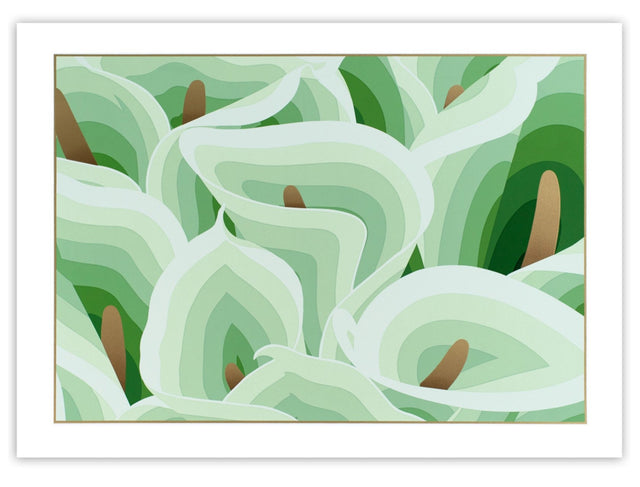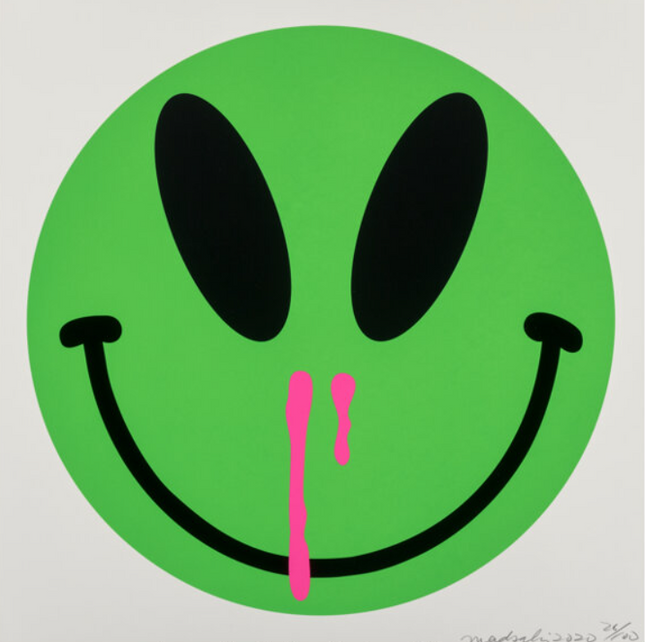
Green

Madsaki Cosmic Overdose_P Offset Lithograph Print by Madsaki
Happiness Overdose Azul Mariano_P Offset Lithograph Print by Madsaki Print on Wove Fine Art Paper Limited Edition Hand-Pulled Street Pop Artwork Graffiti. 2020 Signed & Numbered Limited Edition of 100 Offset Lithograph Artwork Print Size 19.75x19.75 Smiley Face With Bloody Nose in Blue. Kaikai Kiki Co. Ltd, Tokyo. Unconventional Aesthetics of Madsaki's Artwork Madsaki's artwork, characterized by its distinctive use of color and form, critiques modern society's obsession with happiness and the often ironic underpinnings of this pursuit. The "Happiness Overdose Azul Mariano_P" print showcases a smiley face—a universally recognized symbol of joy—juxtaposed with a bloody nose, suggesting an overdose of happiness to the point of harm. This striking imagery, rendered in bold blue on fine art paper, invites viewers to question the true nature of joy and the cost of its excess. The resurgence of pop art in the contemporary art scene is epitomized by the creative convergence of street art and graffiti, with artists like Madsaki at the forefront. "Happiness Overdose Azul Mariano_P," a limited edition offset lithograph print by Madsaki, exemplifies this trend, blending the rebellious spirit of street art with the vibrant aesthetics of pop art. Madsaki's artwork, characterized by its distinctive use of color and form, critiques modern society's obsession with happiness and the often ironic underpinnings of this pursuit. The "Happiness Overdose Azul Mariano_P" print showcases a smiley face—a universally recognized symbol of joy—juxtaposed with a bloody nose, suggesting an overdose of happiness to the point of harm. This striking imagery, rendered in bold blue on fine art paper, invites viewers to question the true nature of joy and the cost of its excess. The Cultural Significance of Offset Lithograph Prints Offset lithography, a common technique for fine art reproduction, allows artists like Madsaki to reach a wider audience by creating multiple copies of original works. This print's size of 19.75x19.75 inches is substantial yet accessible, fitting the urban environments that often inspire street pop art. Hand-pulling each print ensures that every piece retains a touch of the artist's hand despite being part of a limited edition series. The choice of woven fine art paper as the medium further signifies a blend of street art's immediacy and fine art's enduring quality. In the context of street pop culture, limited edition artworks such as "Happiness Overdose Azul Mariano_P" reflect the exclusivity and collectibility that street art has gained in the art market. The limited edition of 100 pieces, each signed and numbered by Madsaki, speaks to the artist's personalized connection with his work and collectors. It represents a shift from the transient nature of traditional graffiti to a more permanent, revered form of artistic expression. Integration of Street Art into Mainstream Art Galleries Madsaki's collaboration with Kaikai Kiki Co. Ltd, Tokyo, a company known for its role in promoting contemporary artists, underscores the increasing integration of street pop art into mainstream art galleries and the broader art world. This partnership illustrates the potential for street-inspired artworks to be celebrated alongside more traditional acceptable art forms, signaling a shift in cultural perceptions and the breaking down of barriers between high art and popular culture. The impact of "Happiness Overdose Azul Mariano_P" extends beyond its visual composition; it encapsulates the evolution of street art into a form that is both a critical commentary on society and a coveted acceptable art commodity. Through his work, Madsaki challenges viewers to reassess their understanding of happiness, consumerism, and the role of art in modern culture. His street pop art & graffiti artwork continue to resonate with audiences around the globe, bridging the gap between underground art movements and the polished white walls of galleries.
$2,500.00


